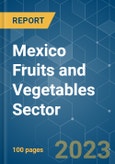The Mexican fruits and vegetable market is projected to register a CAGR of 2.3% during the forecast period.
This product will be delivered within 2 business days.
Key Highlights
- Tomatoes, bananas, chili peppers, oranges, lemons, limes, mangos, and avocados are commonly grown fruits and vegetables in Mexico. The growth of the fruit market in Mexico is driven by various public and private initiatives to increase agricultural production.
- For instance, in 2021, Fortune Growers, a fresh produce company based in Elgin, Illinois, partnered with the Mexican government to strengthen the growth of Mexican produce. With its latest initiative, the company is working closely with small and medium-sized growers across Mexico by creating logistical methods that would increase trade and facilitate growth.
- Mexico is a key exporter of these commodities to the United States due to the Free-trade agreement under USMCA (U.S. - Mexico - Canada Agreement), which helps the United States and Mexico to move goods free of tax.
- Further, orange was the most consumed fruit in Mexico in 2022, with an average per capita consumption of 37.2 kg. Lime ranked second with a per capita consumption of 15.1 kg, followed by banana and mango. Among vegetables, green chili was the most consumed legume or vegetable in 2021, with an average per capita consumption of 16.9 kg, followed by potatoes and tomatoes.
- Fruit and vegetable consumption in the country had declined over the years as fruit, and vegetable-based foods were being replaced with modern self-service stores boosting consumption of instant soups. Hence, there is a need for better marketing campaigns to boost the consumption of fresh and locally produced fruits and vegetables, which are cheaper, and help local growers increase their business.
- The climatic advantages that allow the country to produce fruits and vegetables year-round and increased demand from the United States are the prime drivers of the market studied.
Key Market Trends
Oranges and Tomatoes Dominate the Sector
- According to the Food and Agriculture Organization, primary fruits and vegetables in 2021 were 23.7 million metric tons and 14.7 million metric tons, respectively. Oranges and tomatoes are the leading commodities in the fruits and vegetable sector. The country produced 4.6 million metric tons of oranges and 4.1 million tons of tomatoes in 2021.
- Tomatoes are produced in Mexico year-round, with a fall/winter cycle and a spring/summer cycle stretching over 18 months an agricultural year (AY), from October to March (plus one year). Protected agriculture is increasingly prevalent throughout the country, especially among the farms and enterprises that rely on the export market.
- Tomato production in Mexico is highly concentrated, with Querétaro, Coahuila, Nuevo León, and Puebla having the highest tomato yields due to increased adoption of protected agriculture technologies, like green and shade houses and irrigation systems. For instance, Sinaloa, which grows Roma tomatoes (saladette) in an open field with yields of about 37 MT/ha, can grow the same tomato varieties under protected agriculture with yields ranging from 87 to 200 MT/ha.
- Climate variation in the country, from tropical to temperate, allows growers to produce various fruits and vegetables. About 20% of Mexico’s fruit and vegetable production is exported, while the vast majority goes to the growing domestic market.
- While non-citrus fruits are produced in the more temperate states of Michoacan, Chihuahua, Durango, Zacatecas, and Sonora, citrus production occurs in Veracruz, Colima, Michoacan, San Luis Potosi, Oaxaca, and Sonora. Thus, favorable Mexican weather, expanding cultivation of protected agriculture, and high export demand for those commodities, especially from the United States, are reasons for high production in Mexico.
United States - Major Exporting Partner
- The United States is the top exporting partner of Mexico, whose main competitive advantage is climate. Three-fourths of the US fresh vegetable imports are from Mexico. Most fresh Mexican vegetables arrive in the United States during the winter, when there is little production of the same commodities except in Florida. In 2021, the top categories were fresh fruits (USD 9.8 billion) and fresh vegetables (USD 8.4 billion).
- Mexican farmers invest in protected culture structures, including greenhouses that protect plants from erratic weather and pests, facilitating the production of organic produce and extending crop seasons, enabling the year-round supply of fresh vegetables. Americans are willing to pay a premium for greenhouse-grown and often organic vegetables, and Mexican farmers are investing in protected culture structures to exploit this high-value market.
- Avocadoes, limes, strawberries, raspberries, and grapes are some fruits exported to the United States, whereas bell peppers and tomatoes are the main vegetables exported. The trade agreement, USMCA, and Mexico’s proximity to the United States are prime reasons for such huge exports to the United States. Other prominent trade partners include Canada, Chile, Argentina, and Spain.
- During the 2020-2021 season, tomatoes led the export at about USD 2.5 billion, with most of the exports going to the United States. Avocados were the most exported fruit at about USD 2.8 billion, while walnuts at around USD 48 million.
- Therefore, the high demand for Mexico-produced fresh fruits and vegetables has helped the market to grow during the study period and is expected to witness high growth during the forecasted period.
Additional benefits of purchasing the report:
- The market estimate (ME) sheet in Excel format
- 3 months of analyst support
This product will be delivered within 2 business days.
Table of Contents
1 INTRODUCTION
4 MARKET DYNAMICS
5 MARKET SEGMENTATION
6 PRICE AND INTERNATIONAL TRADE ANALYSIS
7 COMPETITIVE ANALYSIS
Methodology

LOADING...










